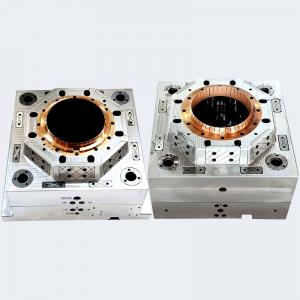Injection Bucket Mould Cooling System Design
Body
Cooling consumes the great majority of clock ticks in every minute of cycle time. As a result, it is a key component in determining a part’s profitability. Mold and component designers are aware of the ramifications, depending on a combination of skill, experience, intuition, prototyping, and CAE analysis to create reliable coolant designs.
This technique allows practical engineers to maximize productivity. In other words, if you build a cooling solution that operates well and reliably for your application, you will be able to spend more time producing high-quality molds as rapidly as feasible.
This article aims to provide a detailed understanding of the injection Bucket Mould Manufacturer, as well as its design procedure. All this while getting into the even smaller details known by specialists in the industry. Do read on to find out more.
WHAT IS AN INJECTION MOLDING COOLING SYSTEM
The purpose of plastic injection mold cooling is to offer heat management throughout the injection molding process. When the hot plastic melt enters the mold chamber, it cools and solidifies due to heat dissipation via the cooling system.
To remove waste heat from an injection molding system, cooling should ideally use either air or liquid. As a result, the system may produce injection mold items that are flawlessly shaped. For it to execute this purpose there are several components required in this injection molding cooling system.
MAIN COMPONENTS OF AN INJECTION MOLDING COOLING SYSTEM
Additional alternatives for increasing injection molding cooling efficiency in difficult-to-reach regions are available in addition to cooling channels internal to the plastic injection mold. Three possibilities for adding to the mold to increase cooling and prevent shrinkage during the cooling step are listed below:
BAFFLES
A baffle is a cooling channel that is drilled perpendicular to the main cooling line. It is equipped with a blade that divides the cooling flow into two semi-circular paths. The coolant enters the blade from one side, rotates through the semicircular pathways, later returning to the main cooling line.
The benefit of this alternative is that it expands the surface area that the coolant can cool, and it can also be a cost-effective solution for mold temperature regulation in challenging places.
BUBBLERS
A Bubbler, which is similar to a Baffle in its capacity to add cooling in challenging regions, is another alternative. The Baffle has a short tube in which the coolant enters at the bottom and bubbles out the top like a fountain. The coolant then flows down the outside of the Bubbler and back to the main coolant line.
This technique is most suited for narrow molding cores that, due to their limited thickness, cannot accommodate a substantial coolant channel.
THERMAL PINS
Thermal pins can be used instead of baffles and bubblers. The pin is a sealed cylinder filled with vaporized fluid that draws heat from the mold. The vapor will condense as it transfers heat to the main coolant, and the process will begin again with the next molding cycle. The thermal pin’s heat transfer efficiency is roughly ten times that of a copper tube, making it an excellent option for increased cooling capacity.
WHY COOLING SYSTEM MATTERS
Changes in mold temperature have the greatest impact on cycle time. This is why mold designers place such a high value on temperature uniformity. Pressure within coolant lines, similar to temperature, should be kept as uniform as feasible. Mold designers must ideally aim for a pressure drop of no more than 5 psi across the mold.
Coolant should flow with appropriate disturbance and blockages will also be easier to recognize with uniform pressure throughout all branches of the injection molding cooling system. Efficient cooling systems aid in overcoming these realities, allowing mold designers to manage temperature, pressure, and time tradeoffs to achieve the ultimate goal: shorter cycle time.
A poorly designed injection mold cooling system increases molding time and production costs.
We are a professional molding company, sell different design of mold, 18L Pail Mould is one of them,welcome to visit our website.













Comments